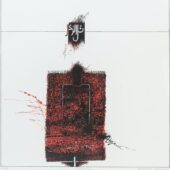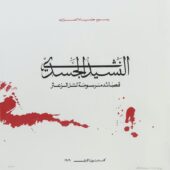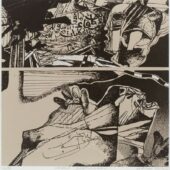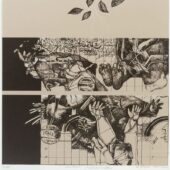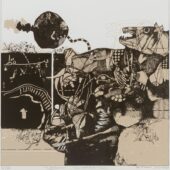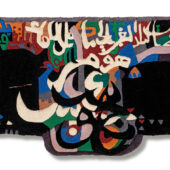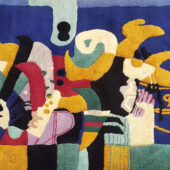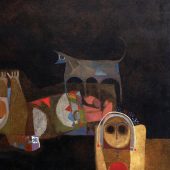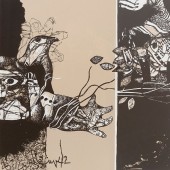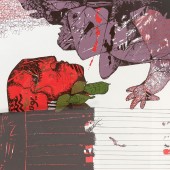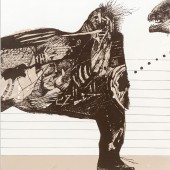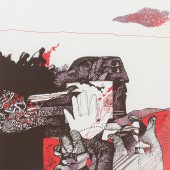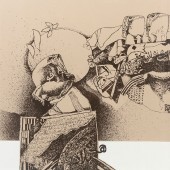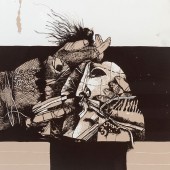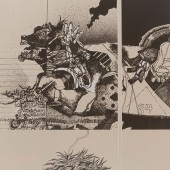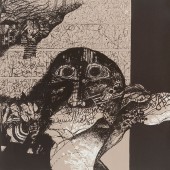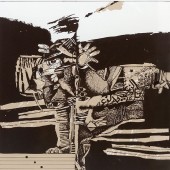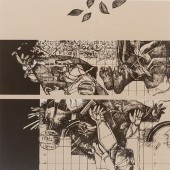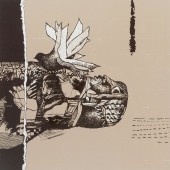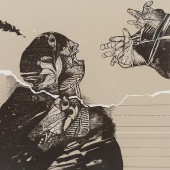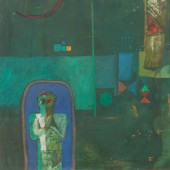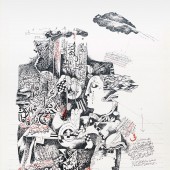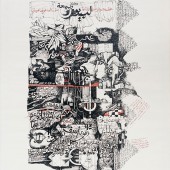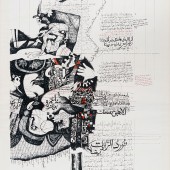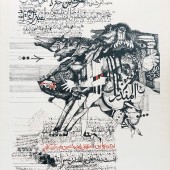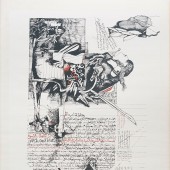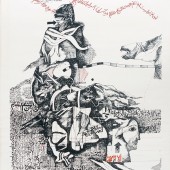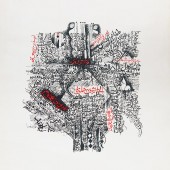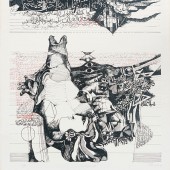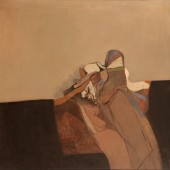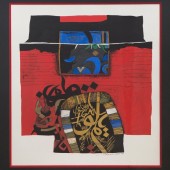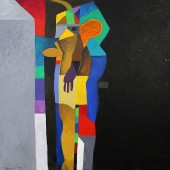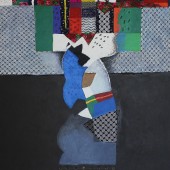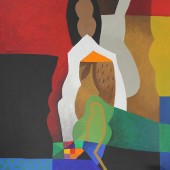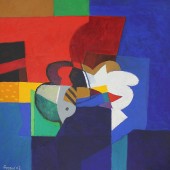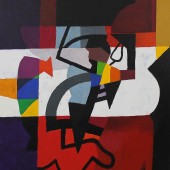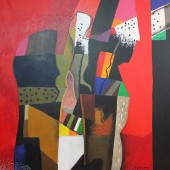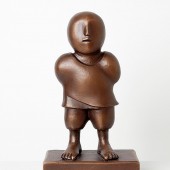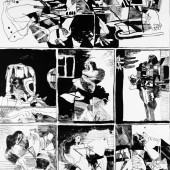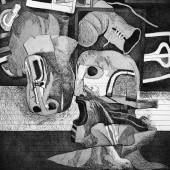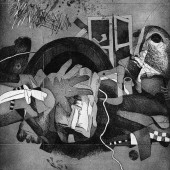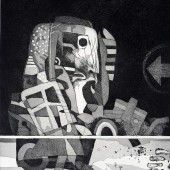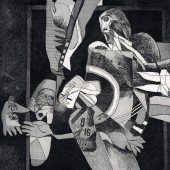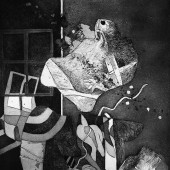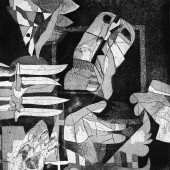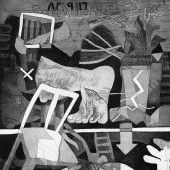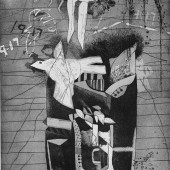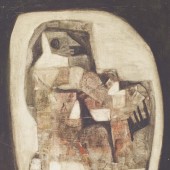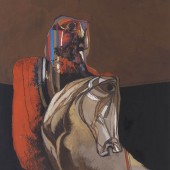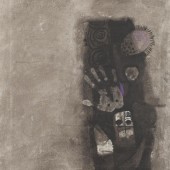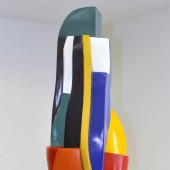Dia Azzawi
- Country: Iraq
- Exhibitions:
- Memory sews together events that hadn't previously met
- Parallel Histories
- A Century in Flux
- Home Ground
- Hurufiyya
- Hurufiyya
- Modern Art From The Middle East
- Night was paper and we were ink
- On This Land
- Peripheral Vision
- Re: Orient
- Sky Over The East
- Taking Shape
- The Sea Suspended
- The Short Century
Poetry and folkloric memory drawn from ancient and contemporary Iraqi and Arab histories resonate in the artwork of internationally renowned Dia Al Azzawi. Azzawi’s acute understanding of antiquity and cultural heritage is evident in paintings, sculptures and prints that capture historical moments, often on a monumental scale. The artist’s awareness and sensitivity to representations of human suffering and turmoil carry through his work, as does his attempt to interlace space and time to demonstrate the eternal solidarity between different cultures and civilisations. In Masks of the Abyss, (1966) Azzawi embedded symbols of human form, including a hand and a masked face, against deep and dark tones of black and gray.
The artist, who received degrees in archaeology from the University of Baghdad in 1962 and fine arts from Baghdad’s Institute of Fine Arts in 1964, worked at Iraq’s Department of Antiquities until 1976, and has since resided in London. Founder of the pivotal Iraqi art group New Vision in 1969, he was also part of One Dimension founded by Shakir Hassan Al-Said. Among Azzawi’s renowned works is the iconic mural Sabra and Shatila (1982-1985), part of the Tate Modern collection, reflecting on the brutal massacre of Palestinian refugees by the Lebanese Christian Phalangist militia during the 1982 Israeli invasion.
Related artists by country
- Ahmed Alsoudani
- Ayad Alkadhi
- Faisal Laibi Sahi
- Halim Al Karim
- Hanaa Malallah
- Hayv Kahraman
- Kareem Risan
- Layla Al Attar
- Nedim Kufi
- Shakir Hassan Al Said
- Suad Al-Attar
- Hafidh Al Droubi
- Ismail Fattah
- Kadhim Hayder
- Saadi Al Kaabi
- Nouri Al Rawi
- Issam Al Said
- Hassan Massoudy
- Jamil Hamoudi
- Rafa Al Nasiri
- Amer Al Obaidi
- Hani Mazhar
- Hanoos Hanoos
- Maysaloun Faraj
- Sinan Hussein
- Amar Dawood
- Nazar Yahya
- Athier
- Ali Talib
- Mahmoud Obaidi
- Khadeir Al Shakarji
- Ali Al Tajer
- Mahmoud Abboud Fahmy
- Ghassan Ghaib
- Jewad Selim
- Salman Al Basri
- Modhir Ahmed
- Salman Abbas
- Sadik Alfraji
- Tawfik Al Alousi
- Ismael Al Sheikhly
- Sama Al Shaibi
- Adel Abidin
- Afifa Aleiby
- Saadi Al Saffar
- Michael Rakowitz
- Abdul Qadir Al Rassam
- Athar Jaber
- Lorna Selim
- Nabil Safwat
- Nadia Osi
- Faraj Abbo Al Numan
- Khaled Al Jader
- Madiha Umar
- Mahmoud Sabri
- Faik Hassan
- Saleh Al Jumaie
- Atta Sabri
- Jananne Al-Ani
- Abdul Qadir Al Obaidi
- Haidar Al-Mehrabi
- Baghdad Benas
- Naziha Selim
- Rajiha Qudsi
- Ismail Khayat
- Nadira Azzouz
- Widad Orfali
- Zaha Hadid
- Latif Al Ani
- Mahood Ahmed
- Mohammed Ghani Hikmat
- Nuha Radi
- Siham Al Saudi
- Suha Sharif Yousif
- Wasmaa Khalid Chorbachi
- Mehdi Moutashar
- Batool Elfekiki
- Jaber Alwan
- Hashim Samarchi
- Naziha Rasheed
